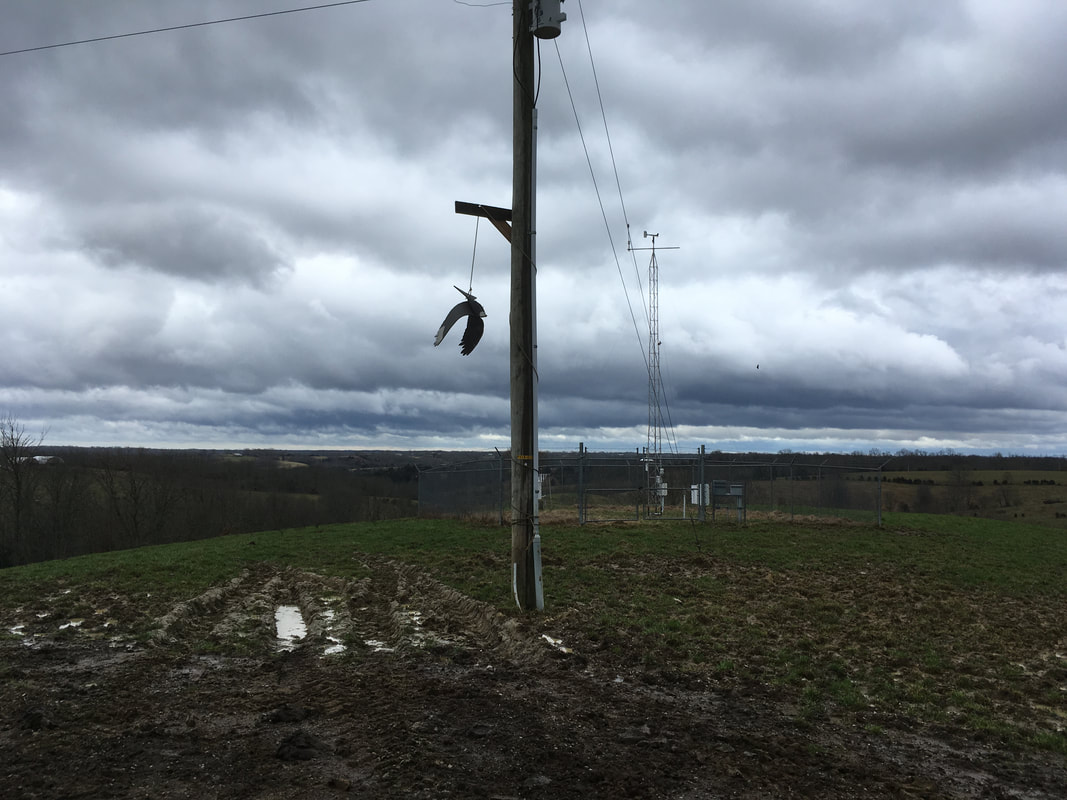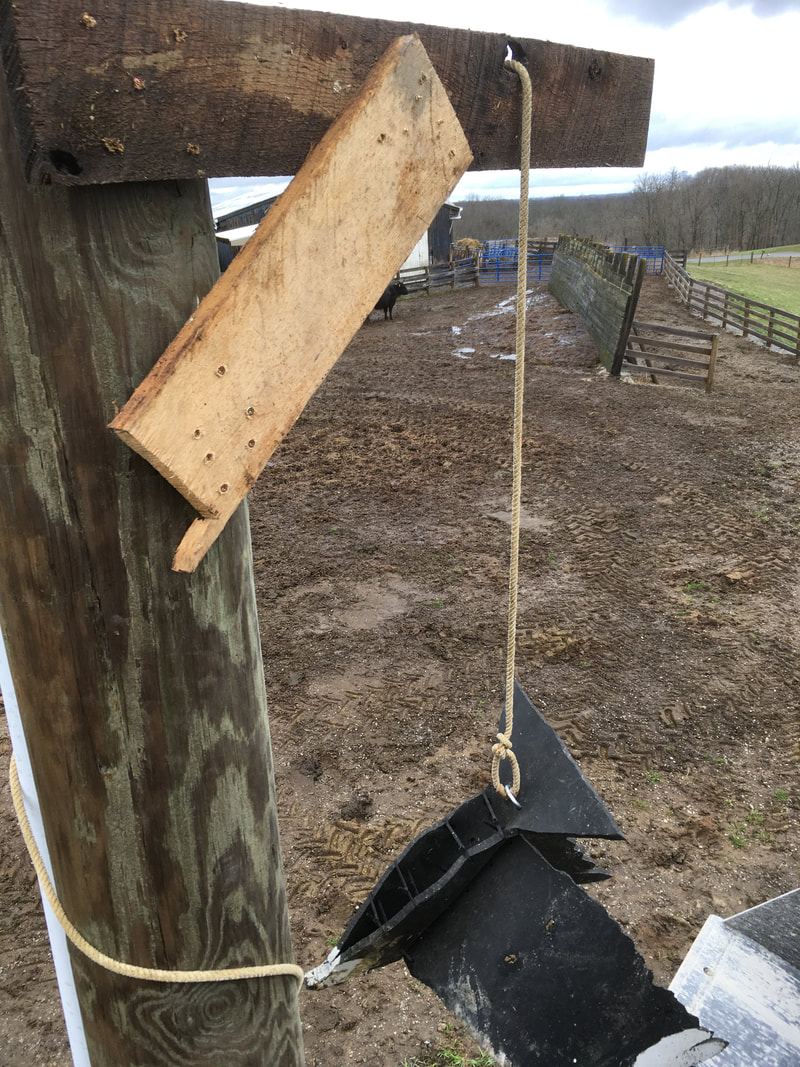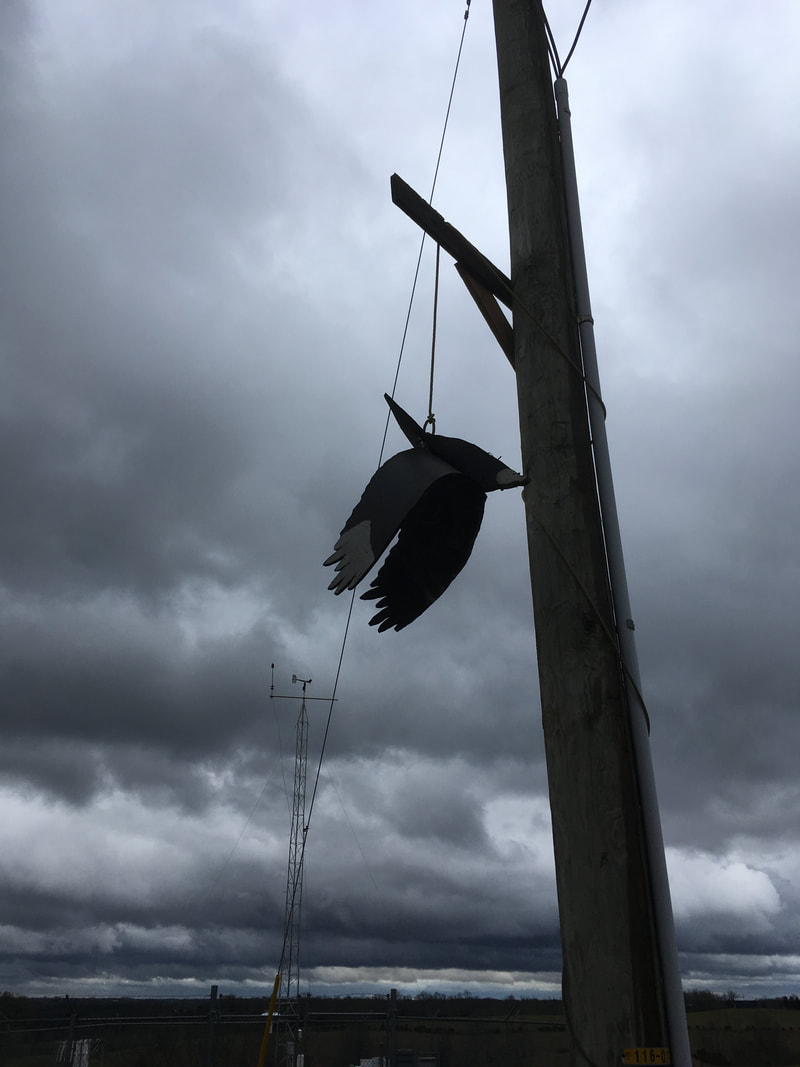|
We have all seen the dreaded sight of buzzards circling above the calving pasture. This should cause alarm, especially with the increased presence of the black headed buzzards (technically called the black vulture). Thanks to the help of the University of Kentucky Department of Forestry and Natural Resources, we were able to try out one of the black vulture effigies (a replica of a dead black vulture). Vultures have a strong sense of mortality and if they see one of their own dead somewhere, they tend to leave that area alone so that they too don't have the same fate. We hung the effigy on a power pole next to the calving barn. The ideal scenario is to have the effigy next to the area you are trying to protect, and have the decoy hanging so that it is free to move with the wind. This will draw more attention to the effigy and have a stronger effect at deterring the vultures. We made a homemade bracket to hang it off of using some scrap 2x6's for a fencing project. We used one with a knot hole so that the rope would not slide around and it would hold the rope out from the pole at a consistent length. We used the tractor to hang the effigy so that it is approximately 10 foot off the ground. Since hanging the effigy we have noticed that it has been successful in keeping the black vultures away from the calving pasture. We have not had any instances of black vultures landing, or harassing the new born calves. Interestingly, the effigy did not seem to deter the red headed turkey vultures. They will still land and eat baby calf manure and afterbirth. I consider this a success since the turkey vultures do not kill animals, they only eat things that are already dead. After we finish calving we will take the effigy down so that the vultures do not get used to it being there all the time. Then next calving season we will hang it back up and hopefully we will experience the same success as we have this year. If you wish to leave it up year round it is recommended that you move the effigy to different locations to keep the vultures form getting used to it, and therefore keeping it effective. If you are interested in building your own effigy you can follow the link below for the directions, provided by the UK Department of Forestry and Natural Resources.
https://forestry.ca.uky.edu/sites/forestry.ca.uky.edu/files/forfs18-03.pdf  Despite February being much warmer than usual, it seems like it has been a rough winter. January was brutally cold, and then Feb and March were brutally wet. Hopefully now that it is April, we are on the downhill slide with the bad weather and the mud. The past month at the farm has been defined by one thing, calving season. This year we have right at 80 females to calve and as of March 12th, we have 48 calves on the ground. The first calf heifers started calving on Feb 14th and 20 of the 27 heifers have calved AI. We bred 30 heifers AI so that means we had an AI conception rate of 66%. The cows didn’t start calving until the 1st of March. They are still calving AI bred calves so I don’t know the AI conception rate for the cows yet. As of right now 60% of the herd has calved in the first 27 days of the calving season. The biggest challenge this year has been dealing with the mud. Eden Shale received 8.5 inches of rain in the month of February. Our saving grace was the infrastructure that we have installed, particularly the calving barn and the hay feeding structures. These structures have allowed the new calves to get out of the mud and have a dry spot to lay down. Another project that we completed this month was to hang up our buzzard decoy at the calving barn. The buzzard is made of a black rubber mat and is made to look like a dead buzzard hanging upside down. Buzzards have a strong sense of mortality and when they see one of their own kind dead, they tend to leave the area as to avoid the same fate. Since we hung the decoy we have not noticed any of the black headed buzzards around. We still do have the red headed buzzards occasionally landing to eat after birth and baby calf manure, but we have not had any black headed buzzards terrorizing the new calves. I am curious to see how long the decoy is effective in the same location. |
Archives
June 2024
Categories
All
Welcome |
CONTACT US |
EMAIL SIGN UP |
|
Eden Shale Farm
245 Eden Shale Rd. Office: (859) 278-0899 Owenton, KY 40359 Fax: (859) 260-2060 © 2021 Kentucky Beef Network, LLC.. All rights reserved.
|
Receive our blog updates
|










 RSS Feed
RSS Feed
